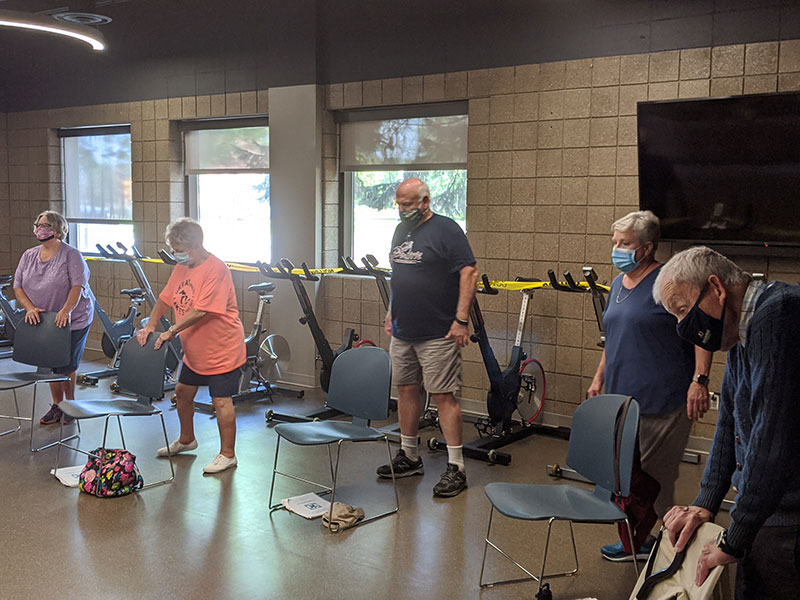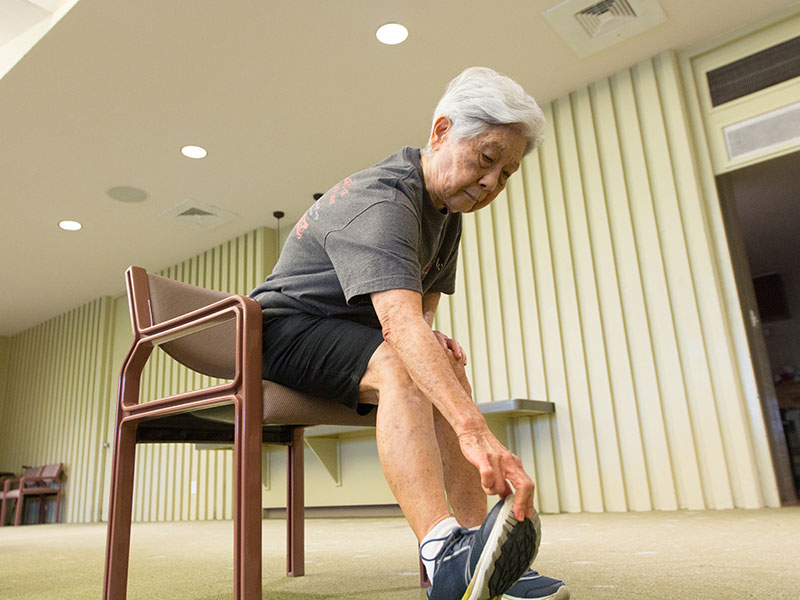One might guess falling less often is just a matter of being more cautious. But there’s more to it than that.
“Ultimately our goal is to keep individuals as independent as they’re able to be,” said Natalie Fick, a Sanford Health physical therapist and master trainer for A Matter of Balance. “I think that’s a big part of what people are taking from this and what they’re most excited about.”
What can people do to prevent falls? What can people do to move around more confidently?
In short, what can people do to safely and assertively live the lives they want to lead?
Sanford Health’s A Matter of Balance classes, SAIL (Stay Active and Independent for Life) classes and Stand Strong fall prevention and education screening events answer those questions.
A Matter of Balance classes are ongoing and include eight sessions lasting two hours each at Active Generations and various locations in Sioux Falls, South Dakota. SAIL is a strength, balance and fitness class offered through Sanford Health and specifically designed for adults 65+.
Participants improve balance and mobility, reduce their risk of falls and improve their quality of life while having fun meeting new people. This is a brand new offering intended to help individuals improve their fitness level to prevent themselves from becoming at risk for a fall.
The first SAIL Class began in October at the Sanford Wellness Center and at Active Generations in early 2022. Stand Strong screening events are scheduled periodically at Active Generations, Good Samaritan campuses, and local churches in Sioux Falls and surrounding areas. Screens take 10 to 15 minutes and are free.
Preventing falls, building confidence
Susan Schave is one of the people who has taken the course. Schave, a longtime Sanford employee now retired, was having problems with her balance when she began taking the class.
She found it helpful, particularly so because it was not about restricting activity. To the contrary, actually.
“It helped me understand how not to be embarrassed about a fall and not be afraid to go out and do things for fear of falling,” Schave said. “I know how to protect myself from falling now. They tell you how to rearrange your house to make it more friendly for walking around.”
Included are instructions on the best places to put grab bars and the best ways to arrange carpets. It’s common sense in many cases, but also a reminder that there are ways to improve your capacity to move around while maintaining safety.
“I’ve told a number of people I’m taking the class,” Schave said. “I think it would be beneficial for anybody who is having problems — or even before you start having problems. If you’re getting a little older and you feel like you’re not as stable physically as you used to be, I would encourage anybody to take the class.”
Instructors encourage exercises that focus on strengthening weak muscle groups. For Schave, that meant targeting her ankles and thighs.
“They’re not very strong, especially from quarantine and all that sitting around,” Schave said. “I’m strengthening them and they’re helping my balance.”
Falls by the numbers
Statistics from the Centers for Disease Control and Prevention bear out a definite cause for concern. The state of South Dakota, for instance, ranks fifth in the country for death from falls among older adults.
Nationally, every 11 seconds an older adult is treated in the emergency room for a fall and every 19 minutes an older adult dies from a fall.
As a level II trauma center, Sanford Health records and reviews causes of injury that bring people to the hospital. Carly Farner-Cordell, Sanford Health trauma coordinator, sees the numbers.
“Falls are definitely our No. 1 cause of injury for head injury, hip fractures and arm fractures,” Farner-Cordell said.
Farner-Codell did a needs assessment for the programs Sanford Health had in place to prevent falls. That’s where A Matter of Balance began.
“A lot of people believe that falling is a natural part of aging,” Farner-Cordell said. “But the research shows that’s not the case. So the goal for our prevention injury programming is to make sure that we have education opportunities in place in the community that will let people know that they should talk to their provider if they’re afraid of falling. Or if they feel dizzy, they should have their medications reviewed.”

Photo by Sanford Health
Screening questions
Fall prevention also addresses other possible causes for falling and the ramifications that can extend beyond the actual injury. In some instances, individuals may be hesitant to report falls for fear it could lead to a loss of independence.
“I think sometimes they don’t want to tell anybody,” said Karla Cazer, an A Matter of Balance master trainer and Sanford Health geriatric clinical nurse specialist. “They could be thinking, ‘Oh my gosh, my family might make me move to an assisted living facility.’ Or they might be thinking people will say they need more help in the home.”
Falls can be the cause of injury, obviously, but also could be a sign of other issues that need to be addressed. It could be an indication that the inactivity brought on by the pandemic has become a problem, for instance. It could be something as serious as a heart problem or a stroke. Or, as easy to remedy as moving furniture around.
When screening for susceptibility to a fall, the top three factors are these:
- Have you fallen in the last year?
- Do you feel unsteady when you’re standing or walking?
- Do you worry about falling or have a fear of falling?
“Our classes are centered around reducing the fear of falling so that people can become more active and increase their strength and ability to feel more steady,” Cazer said. “It’s about how to be more assertive for yourself.”
Options for staying safe
Both Sanford and the Good Samaritan Society employ STEADI (Stop Elderly Accidents, Deaths and Injuries) initiatives that were created by the CDC to assist physicians and other health care providers in preventing falls. STEADI serves to screen patients to identify their fall risk, assess risk factors that can be changed, and find ways to reduce risk using clinical and community-based strategies.
“We utilize the evidence-based program, STEADI, to help identify if an individual has a fall risk,” said Martha Frohwein, Good Samaritan Society clinical director. “Within the Good Samaritan Society and across our service lines and various levels of care, A Matter of Balance is one of the programs we use to help support individuals who would benefit.”
Ultimately, a key message of STEADI is that getting older does not have to mean falling is more likely. There are ways to live safer while staying active.
“One of the things we really want to do is to educate people that falling is not an inevitable part of aging,” Frohwein said. “There are specific strategies or things people can do to decrease their risks of falling whether they’re living alone, in a senior living setting or in a long term care environment. Encouraging people to talk openly with their health care provider can be a great way to initiate that conversation.”
Find classes and events:
Please contact (605) 333-4440 or visit sanfordhealth.org with any questions about our classes or screenings offered in Sioux Falls. The Geriatrics and Senior Services team is proud to be sponsored by grant funding to make events possible for participants and their families.
This project was supported, in part, by grant number 90FPSG0043-01-00, from the Administration for Community Living, U.S. Department of Health and Human Services, Washington, D.C. 20201. Grantees undertaking projects with government sponsorship are encouraged to express freely their findings and conclusions. Points of view or opinions do not, therefore, necessarily represent official ACL policy.
Sanford Health requires masking in its locations. Anyone shown without a mask was either recorded prior to COVID-19 or recorded in a nonpatient care area where social distancing and other safety protocols were followed.
Read more
- Protection from winter slips, trips and falls
- Exercise, social time can slow progression of Alzheimer’s
- Fall prevention top of mind as risk increases in pandemic
…
Posted In Emergency Medicine, Healthy Living, Rehabilitation & Therapy, Senior Services
